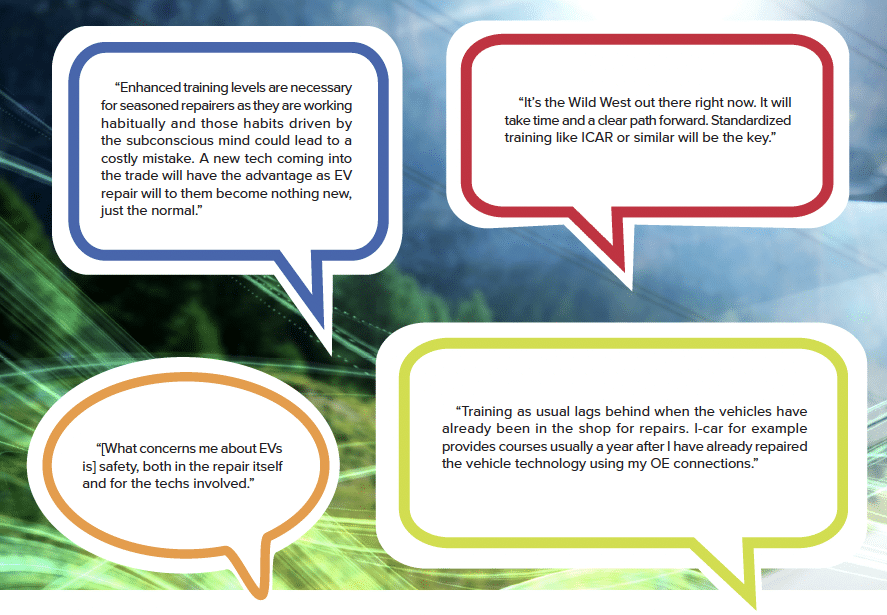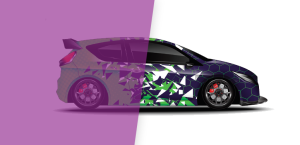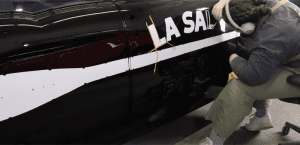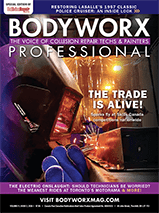ELECTRIC VEHICLE AMBIGUITY MAY CAUSE FEAR, BUT INDUSTRY EXPERTS HAVE THE ANSWERS
BY SARAH PERKINS
As the automotive industry continues to rapidly evolve, the push for electric vehicles (EVs) presents a new opportunity for innovation and technological advancements. However, this transition to electrification also presents unique challenges and a charged learning curve that for many, presents fears for the future. We reached out to the industry as well as some EV experts to answer what challenges exist and why it’s imperative to be equipped with the knowledge and expertise necessary to effectively navigate the repairs that are quickly driving towards tomorrow’s horizon.
Bodyworx magazine polled the industry to ascertain what electrification means to those at the heart of repairs. Results found that the majority of respondents are concerned about the safety of technicians as well as access to training and investment in proper tools. Of those polled, 96.6 percent of respondents specifically felt that additional training and support should be provided to collision repair technicians to ensure their safety while working on high-voltage systems. Additionally, 50 percent of respondents stated that they had not received industry training on electric vehicles.
“Adherence to safety protocols and repair procedures is imperative for technicians servicing EVs, mirroring the caution required for gas vehicles—such as avoiding torching a gas tank out of a vehicle during repairs.”
—DAVID GILES, ELECTRIC VEHICLE SPECIALIST AND CO-FOUNDER OF POWEREDEV CONSULTING


Similarly, when speaking with David Giles, electric vehicle specialist and co-founder of PoweredEV consulting, about the reason technicians new to EVs may be fearful towards the technology, he noted that the “the primary reason why untrained technicians may find electric vehicles (EVs) daunting isn’t due to the complexity of the tasks or necessary skills, but rather the apprehension surrounding high voltage and the potential for costly damage to the system.”
Although electric vehicles have less moving parts to their internal combustion engine (ICE) counterparts, with the average EV having around 20 moving parts versus an ICE’s 2,000, Giles further noted that “despite the straightforward nature of the work involved, understanding the critical aspects of safety, and comprehending how EV systems function are important. Once technicians acquire a solid understanding of vehicle electronics and logistics, they’ll realize that EVs aren’t fundamentally distinct from traditional vehicles, with training being the key investment for transitioning to electrification.”
When considering differences between an electric and an ICE vehicle, for Giles, “the most notable distinctions lie in the absence of combustion engines, multi-speed transmissions, and the presence of high voltage systems, alongside the elimination of fuel and emission components.” Because of this, repairers preparing for electrification “will find themselves relying more on scan tools and electrical testing equipment for high-voltage systems, while mechanical systems remain largely unchanged from internal combustion engine (ICE) vehicles.”
Moreover, while the high-voltage systems and their potential risks are often the cause of the most fear, Giles stressed that “the perceived risk of fatalities or injuries from high voltage systems is minimal due to redundant safety mechanisms and the isolated design of high-voltage systems.” However, “adherence to safety protocols and repair procedures is imperative for technicians servicing EVs, mirroring the caution required for gas vehicles—such as avoiding torching a gas tank out of a vehicle during repairs.”
In embracing the challenge of the charged learning curve, Giles outlined how “several organizations now provide EV training, starting from basic electrical and electronic principles, progressing to safety protocols, and then covering maintenance, repair, and battery disassembly.” And, “despite common belief, the core of EV training should prioritize understanding of service information, establishing a strong electrical foundation, comprehending power flow in EVs, adhering to safe work practices, and mastering equipment usage, rather than solely focusing on battery replacement and cell/module handling. This would be from more advanced training programs.”
Ultimately, for Giles, making the transition to electric vehicles is a process of “mastering the fundamentals of electricity, including Ohm’s law, and familiarizing oneself with service information and the appropriate utilization of safety equipment.”
“Electric vehicles are here. Whether you like it or not, they will soon be rolling into your shop and out of warranty. Be ahead, before you fall behind.”
—SAIFULLAH SANAYE, PROFESSOR OF AUTOMOTIVE TECHNOLOGY AND EV EXPERT
Similarly, Saifullah Sanaye, Professor of Automotive Technology and EV Expert, echoes Giles in the belief that “the majority of today’s technicians are afraid of electric vehicles.” For Sanaye, “the reason behind this is,” as Giles notes, “is the misconception that these vehicles are unsafe to work on due to the high-voltage that is present, and my response to those technicians is that if you get the proper training, it will ease your ‘high-voltage anxiety’ and also allow you to work safely on these vehicles.”
Moreover, Sanaye further echoed Giles in the assertion that “just because EVs have less moving parts, it does not mean that they will be easier to fix. In my opinion, from a technician’s point-of-view, internal combustion engine (ICE) vehicles have more hardware and EVs have more software. Sometimes, software issues can be a lot more complex to diagnose than hardware issues.”
But, despite the potential complications, Sanaye encourages technicians to not get overwhelmed by high-voltage-havoc because manufacturers have made sure that EVs are built with systems “designed to be extremely safe.”
And, while many questions about electric vehicles exist, there are also many who are willing to provide answers. In particular, Sanaye described how he, in partnership with AIA Canada and the Canadian Government, have worked to create and produce a complete EV training course (ev-training.ca), designed to “help today’s technicians navigate the new world of electric vehicle diagnostics and repair.” In this way, while EV uncertainty may continue into the near future, for Sanaye, technicians need to “get ready!” “Electric vehicles are here. Whether you like it or not, they will soon be rolling into your shop and out of warranty. Be ahead, before you fall behind.”


























